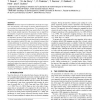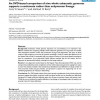407 search results - page 40 / 82 » TREC Genomics 2004 |
109
click to vote
BMCBI
2004
14 years 11 months ago
2004
Background: In addition to known protein-coding genes, large amounts of apparently non-coding sequence are conserved between the human and mouse genomes. It seems reasonable to as...
BMCBI
2005
14 years 11 months ago
2005
Background: Enhancements in sequencing technology have recently yielded assemblies of large genomes including rat, mouse, human, fruit fly, and zebrafish. The availability of larg...
BIOINFORMATICS
2007
14 years 12 months ago
2007
Motivation: Genome maps are fundamental to the study of an organism and essential in the process of genome sequencing which in turn provides the ultimate map of the genome. The in...
110
click to vote
BMCBI
2004
14 years 11 months ago
2004
Background: Eukaryotic whole genome sequences are accumulating at an impressive rate. Effective methods for comparing multiple whole eukaryotic genomes on a large scale are needed...
BMCBI
2005
14 years 11 months ago
2005
Background: The availability of the human genome sequence as well as the large number of physically accessible oligonucleotides, cDNA, and BAC clones across the entire genome has ...


